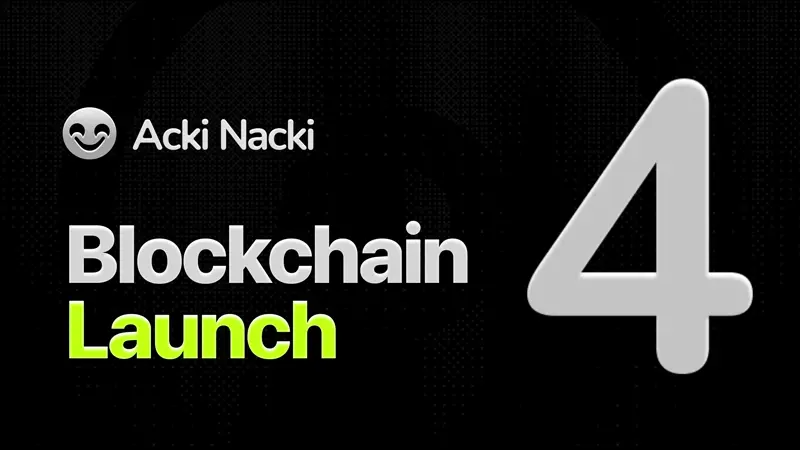When you’re early in a project, you turn into a digital prospector.
You scrape the internet for every scrap of information, half-finished docs, stray Telegram messages, random X posts at 3 a.m, because that’s where the real nuggets are.
Sometimes those nuggets are hype. Sometimes they’re noise.
And sometimes, they’re exactly the kind of signal that tells you where this whole thing is headed.
This week, I hit one of those veins: a fresh X post from Acki Nacki founder Mitja Goroshevsky. Not marketing fluff, not “soon™” teasers, but a point-by-point breakdown of why Acki Nacki is designed to avoid the fate of Roman Storm, Tornado Cash’s co-founder, who just got convicted.
It’s the kind of post most people scroll past. But if you’re building in Web3 or betting on it, you stop and read twice.
And then you start connecting dots. Let’s do that together.
Roman Storm, Tornado Cash, and why Acki Nacki sleeps better at night
Roman Storm, one of Tornado Cash’s founders, has just been convicted for running an unlicensed money-transmitting business. Sounds dry until you dig into how the jury reached that verdict, and why it matters to anyone building decentralized tech.
The short version? Roman got nailed not simply for creating privacy tech, but for the way it was controlled, run, and profited from. Acki Nacki’s design is built to avoid every single one of those legal pitfalls. Not by accident but by design.
Let’s walk through the differences, point by point.
1. No “Operator” to Target
Roman was convicted for operating Tornado Cash and knowingly moving dirty money. Acki Nacki is built so there’s no one you can point to and say, “that’s the operator.” The protocol runs itself.
2. No Lifelong Admin Keys
Prosecutors showed Roman had full admin keys at launch, and kept them.
Acki Nacki? Keys exist only for a few weeks after launch to patch emergencies, then they’re destroyed on-chain for everyone to see. Permanent control is impossible.
3. No DAO Politics, No Token Governance
Tornado had a DAO, governance tokens, and founders actively involved.
Acki Nacki? None of that. Rules are hard-coded from day one. No governance drama. No “association” the government can frame as a business partnership.
4. No Profit From Transfers
Roman earned from token sales, VC deals, and cash-outs.
Acki Nacki has no token sale, no VC allocations, no treasury, no usage fees. If the network moves funds, no dev gets a cut.
5. No Single UI Chokepoint
Storm ran the only official front-end, so control over that meant control over access.
Acki Nacki’s UI is open-source, non-custodial, and keys never leave the user’s device. Hosting the UI doesn’t mean touching the money.
6. Even the UI Is Decentralized
Tornado had one founder-run interface.
Acki Nacki has a decentralized UI layer for validators and license owners, no single point to attack legally or technically.
7. No Central Roadmap
Storm kept running the show, updates, promotion, new features.
Acki Nacki has no central team pushing features to attract specific users. All ongoing dev is about mining and security, not marketing transactions.
8. No Cozying Up to Criminals
Prosecutors proved Storm knew North Korea’s Lazarus Group was laundering through Tornado and let it run.
Acki Nacki is a general-purpose network. It doesn’t cater to, or build features for, shady actors.
9. No “Money Transfer Business” Narrative
In court, Tornado’s founders were painted as members of an “association” running a financial service.
Acki Nacki devs? They’re in the same category as Bitcoin Core contributors, maintaining open-source code, not processing user transfers.
How Acki Nacki’s Safety Features Work in Practice
🔑 Launch Mechanics
-
At genesis, there are temporary emergency keys for fixing critical bugs in the first weeks.
-
These keys are scheduled for on-chain destruction, meaning anyone can verify they no longer exist.
-
After that, no one, not even the original devs, can change the protocol rules.
💰 Tokenomics Without a Legal Tripwire
-
Two tokens exist: $NACKL (network security, 10.4B capped supply) and SHELL (unlimited, used for pledge computation).
-
No Token Generation Event (TGE), no pre-mine for insiders, no VC allocations, no dev-controlled treasury.
-
Tokens are earned only through mining, staking, or verifiable on-chain participation.
-
The economics are modeled so network security grows without any party profiting directly from user transactions.
🖥 Decentralized UI Layer
-
The UI for interacting with the chain is open-source, non-custodial, and locally key-managed.
-
Validator/license owners can host their own front-ends, each pointing to the same protocol.
-
This means no single server, website, or entity can be shut down to “stop” Acki Nacki.
-
Even the “official” front-end is just one of many possible access points, not a legal chokehold.
📜 Immutable Governance
-
From day one, there’s no DAO, no voting, no founder power to tweak parameters.
-
Rules are set in code and can only be changed via a new network (which would require everyone to opt-in voluntarily).
The Takeaway
Roman Storm’s conviction is a case study in what not to do if you’re building decentralized systems.
Acki Nacki sidesteps every trap: no lasting control, no governance capture, no profit motive tied to usage, no central chokepoints, and a UI model that’s legally bulletproof.
It’s not just “more decentralized” as a buzzword. It’s architected so that if a courtroom drama ever happens, there’s simply no chair with your name on it.





